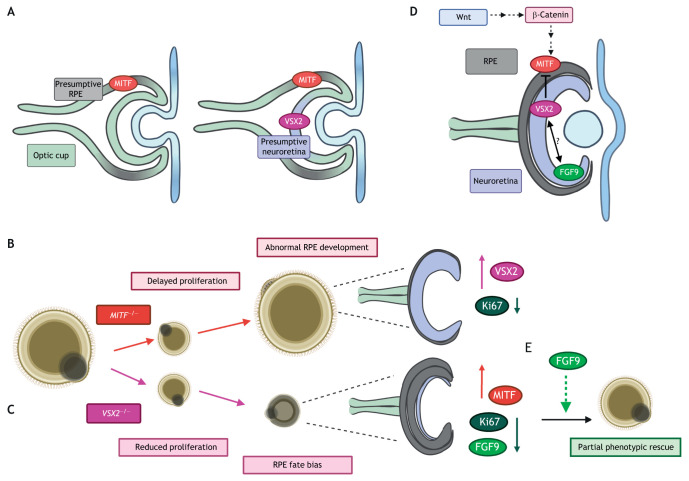Fig. 3.
Optic cup morphogenesis: a model of temporal inhibition and synergism. (A) During optic cup formation and invagination, micropthalmia-associated transcription factor (MITF) and visual system homeobox 2 (VSX2) specify the presumptive retinal pigment epithelium (RPE) and neuroretina domain, respectively. MITF expression precedes VSX2 expression. (B,C) Studies using pluripotent stem cell (PSC)-derived MITF- and VSX2-mutant retinal organoids confirmed phenotypic findings. (B) MITF-mutant organoids exhibit delayed proliferation and downregulation of the proliferation marker Ki67 in early development, although long-term growth is unaffected. RPE develops abnormally and expression of the neuroretinal determinant VSX2 is upregulated. (C) VSX2-mutant organoids exhibit reduced proliferation in early development, followed by a fate bias towards RPE rather than neuroretina. Accordingly, downregulation of proliferation marker Ki67 and upregulation of RPE determinant MITF are apparent. (D) These studies also elucidated a novel model of VSX2 and MITF function and interaction in early retinogenesis. Before direct repression of MITF by VSX2 at the stage of determination of the neural retina and retinal pigment epithelium domains, MITF may play a role in proliferation during early development, potentially by acting downstream of the canonical Wnt/β-catenin pathway. (E) Exogenous expression of fibroblast growth factor 9 (FGF9) partially rescues the mutant phenotype, increasing expression of VSX2, but proliferation remains delayed. FGF9 may therefore work in concert with VSX2 to regulate early optic cup development (D).

